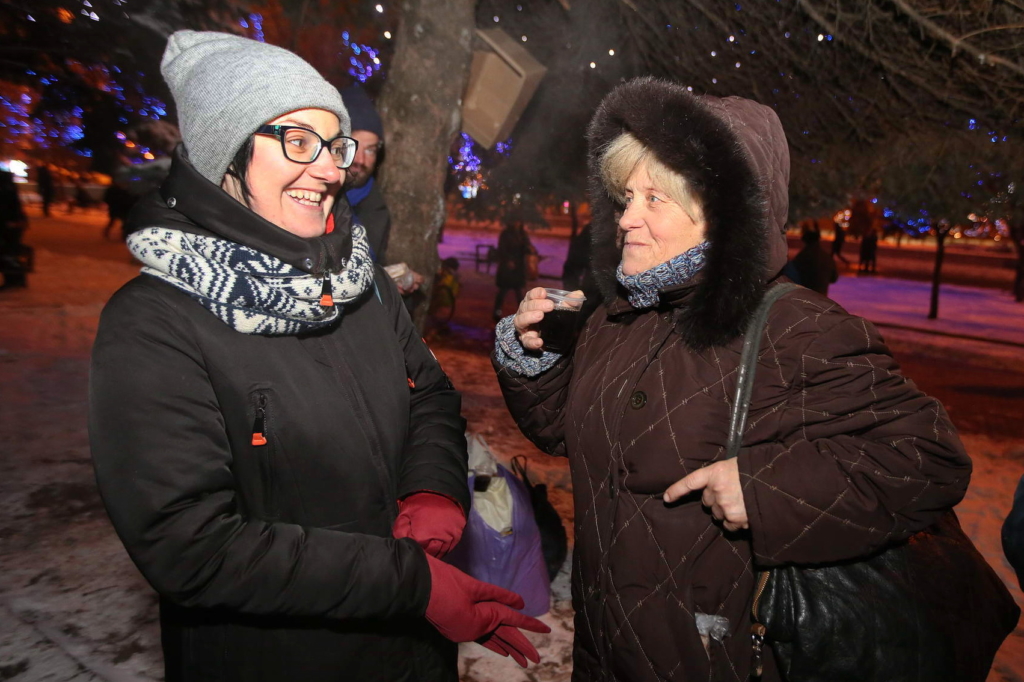Editor’s Note: This article is a part of the “Journalism of Tolerance” project by the Kyiv Post and its affiliated non-profit organization, the Media Development Foundation. The project covers challenges faced by sexual, ethnic and other minorities in Ukraine, as well as people with physical disabilities and those living in poverty. This project is made possible by the support of the American people through the U.S. Agency for International Development and Internews. Content is independent of the donors.
When Olha Makar went to a charity event in Kyiv to help hand out food to the homeless people for the first time, she didn’t want “to save the world,” but rather to just try something new.
Ten years later, she heads an organization helping homeless and Romani people in Kyiv.
“We try to be friends with people. That is why we never get tired of what we are doing,” Makar says. “We believe that a life could be lived joyfully, and friendship with homeless people brings this joy.”
According to the city authorities, there were 5,500 homeless people in Kyiv as of the end of 2017. However, Makar, 28, believes that those are only the ones who visited the city’s Center for Registration of Homeless, and the real number is significantly higher.
Schoolkids, college students and adults volunteer for Makar’s Youth for Peace organization: They meet four times per week to prepare food, usually tea and sandwiches, and then hand it out to the homeless at the pre-agreed time and places.
Also, they work with the Romani people, mostly kids, teaching them reading, writing, playing with them, and collecting clothes for them. The number of Roma living in Kyiv is unknown: The last census was carried out in 2001. Also, many Roma lack identity documents, and they move from place to place. Makar says there are 50-70 Romani people whom they help regularly.
According to Makar, one of the factors that helped the organization grow were social media, which attracted more and more volunteers. Since Youth for Peace don’t have any constant sponsors, the organization’s members fundraise, apply for grants and invest their own money.

Olha Makar talks to homeless people as she volunteers for Youth for Peace organization that helps homeless and Romani people on Jan. 17 in Kyiv. (Kostyantyn Chernichkin)
Complex solution
In Kyiv, there is only one state center that provides social and legal help to the homeless, and can host up to 166 people to spend a night in it. However, a night there costs Hr 10 ($0.4), plus the cost of public transport to get there. Those who do get there can end up being turned down if the center is full. Those who can’t afford to pay can stay for free for five nights, but it involves a complex bureaucratic procedure.
Makar’s organization is now collecting money for opening a similar center of their own, and hopes to launch it by the end of 2018. She says that often a homeless person needs some psychological support the most.
“Thus the solution to this problem should be complex. You can’t just find a place for the homeless to live in. If you don’t help the person overcome their psychological problem, nothing will work out,” says Makar.
According to Makar, another important issue is to change people’s attitude towards homeless people, making them pay more attention to the homeless.
“Sometimes a person can just fall unconscious or asleep on a street. If nobody wakes them up, they can freeze to death. Sometimes to remind people not to be indifferent means to save someone’s life,” Makar says.
That is why Youth for Peace runs informational online campaigns raising people’s awareness towards the homeless.

Building a dialogue
Just like the homeless, Romani people are often isolated from the society in Ukraine. Youth for People started helping them in 2012, after the Roma camp burned down near Kyiv.
“We found them in a forest where they lived near the landfill. We started to communicate with them, mostly with children, and found out that they were very open to speaking with us,” Makar says, adding that adult Romani people usually feel intimidated by the non-Roma people, since they face aggressive or intolerant attitude towards them.
It took Makar’s team three years to establish the communication with certain people from Roma community, she says.
Volunteers say they see the biggest results of their work in the behavior of children, with whom they play, talk, and whom they teach. These children learn how to behave among other people and speak Ukrainian. However, there’s still a long way to go, Makar says: More work needs to be done, more money needs to be raised.
“I don’t think that someday I will stop doing this,” she says. “I believe the power of our community is in cooperation.”
Where and when volunteers hand out food:
Tuesday
Lisova metro station, near the underground passages. 7:30 p.m.
Darnytsia metro station, near McDonald’s. 7:30 p.m.
Podil district, near Frolivsky Monastery (8 Frolivska St.) 7:30 p.m.
The square near the entrance to South Railway Station. 7:30 p.m.
Wednesday
Near the Central Post Office at Maidan Nezalezhnosti Square. 8 p.m.
Thursday
Podil district, near the monument to Petro Sahaidachny. 5:30 p.m.
To become a volunteer or send money to the Youth for Peace initiative, go to www.facebook.com/molod.za.myr/
